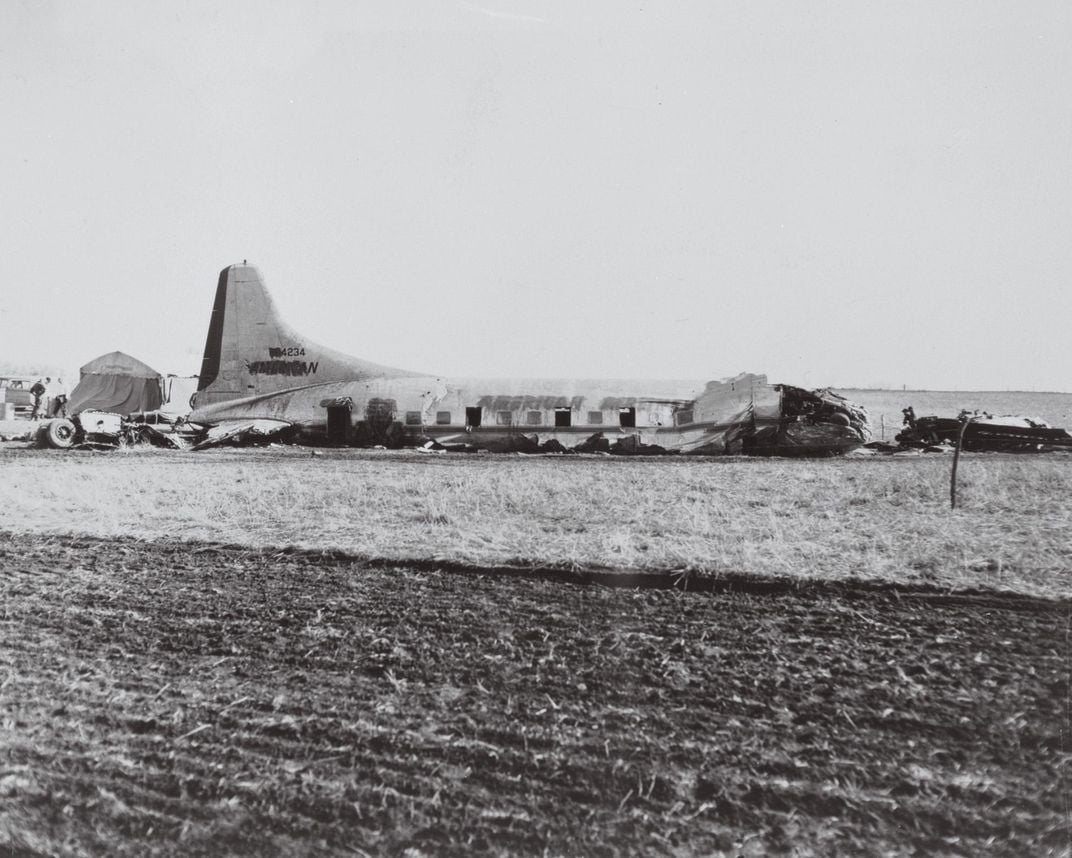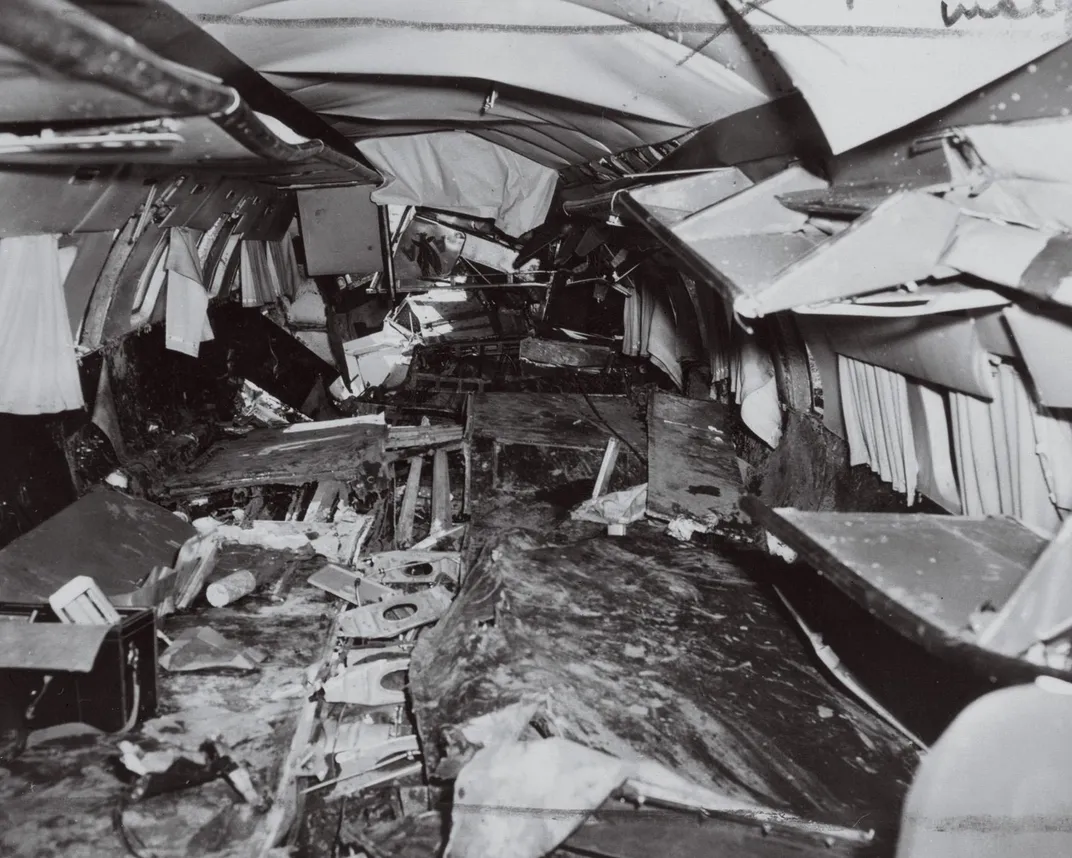How the Airline Industry Got Wise to Seat Belts
The complex history of a simple safety device.
:focal(973x1152:974x1153)/https://tf-cmsv2-smithsonianmag-media.s3.amazonaws.com/filer/66/b9/66b9724c-d1e1-4241-aa26-ab4282b2aa99/05-2b_as2021_passengerseatbelts_maryevans_11956039_live.jpg)
Charles N. Monteith, chief engineer at Boeing Airplane Company, was upbeat when he gave his presentation at the May 1929 aeronautical meeting of the American Society of Mechanical Engineers. He suggested that airplane passenger cabins would soon afford the same amenities as rail travel. Parlor-car comfort, Pullman style, was the aesthetic aircraft designers hoped to emulate.
With prophetic certainty, Monteith proclaimed that “…sleeping compartment, smoking rooms, an observation platform and arrangements for serving meals” would soon be standard features in commercial air travel. The engineer assured his audience that safety was also at the top of Boeing’s agenda. Parachutes—once contemplated for passengers—were rejected, the proposal nixed by American and European carriers. “As for safety belts,” he said, “British and Dutch opinion is against their installation. Most of the transports operating in the United States today do not provide belts for the passengers, but it is being demonstrated rapidly that they are sometimes very necessary.”
Monteith highlighted the injury risk that came if passengers were tossed around, not in a crash, but in turbulent air or “just prior to landing.” Buckling-up was to prevent travelers from becoming human projectiles in the cabin, not as a strategy for surviving a smash-up. Although in 1929 passenger safety belts were considered optional, men like Monteith believed seat belts were common sense—only the next accident away from being mandatory equipment.
/https://tf-cmsv2-smithsonianmag-media.s3.amazonaws.com/filer/1f/b6/1fb60ad5-4b2a-41c2-b588-983051a748c7/05-2a_as2021_passengerseatbelts_dehavenviaweillcornellp9119_live.jpg)
Twenty years later, seat belts were so widespread that they got a cameo of sorts in the 1950 motion picture All About Eve. In the starring role, a gravelly voiced Bette Davis as spoiled diva Margo Channing, starts up a stairway, stops, turns back to her guests, and delivers a caustic warning: “Fasten your seat belts. It’s going to be a bumpy night.” The reference revealed how familiar the public was with strapping into an airliner seat. Seat belts had become common, but their use wasn’t a settled matter with the flying public, despite Margo Channing’s famous command.
By 1950, a lot of money and brain power had been poured into U.S. aviation research thanks to World War II. The Committee on Aviation Medicine, a group of scientists and engineers concerned with flight and human physiology, had been established in autumn 1940 by the National Research Council. The committee’s focus was straightforward and urgent: Improve the effectiveness of airplanes operating in wartime conditions and the survival rate of their crews. Dr. Eugene DuBois, a faculty member at Cornell Medical College, headed the effort. Cornell’s involvement deepened in 1942 when DuBois’ colleague, Hugh DeHaven, established the Crash Injury Research (CIR) project at New York Hospital-Cornell Medical Center. DeHaven, who served as director and principal researcher at CIR for a dozen years, did pioneering work in the field of aviation safety. He was the lead investigator on several well publicized reports that championed the benefits of safety features like seat belts in reducing serious or fatal injuries to passengers and crew members.

But in 1947, debates raged over the safety of seat belts. In a New York Times piece published on November 20, DeHaven ridiculed the rumor that lap belts were unsafe. He described this misconception, which still rippled through the public, as “dangerous,” the result of “ignorance and superstition.” He asserted that “…the false conviction that the use of safety belts would cause internal injury when crashes occur” had cost lives. Following DeHaven’s comments, thanks to public education campaigns, significant gains were made in dismantling the lingering belief that seat belts caused internal injuries.
Then, on October 31, 1950, less than three weeks after audiences first heard Margo Channing’s endorsement of belts, a tragedy seemed to upend the wisdom of her words. That Halloween night, of the 30 individuals who boarded a Vickers VC-1 aircraft—dubbed the Lord St. Vincent—for a regularly scheduled run from Paris to London, 28 perished in a grisly accident. The British European Airways flight departed from Paris’ Le Bourget airport at 6:39 p.m. bound for London’s Northolt. As the twin-engine airplane drew closer to London, fog closed in. At 7:25 p.m., the pilot, Captain Clayton, checked in with Uxbridge Air Traffic Control and was informed that visibility at Northolt was less than 50 yards. Clayton opted to forego a landing. He diverted to Heathrow and, after clearance from ground control, began the airplane’s descent on course for runway 28.
Four hundred yards out, the captain radioed the tower that he was overshooting the landing. But the craft was too low to pull out. Undercarriage retracted, the airplane touched down at a 20-degree angle with an estimated speed between 80 and 120 knots. It skidded over 100 feet, bounced, was airborne again for a half-mile, and finally thudded back to earth before catching fire. Only one flight attendant and one passenger survived.
When official inquiries began, Dr. Donald Teare, the go-to guy for autopsy examinations in celebrity deaths and high-profile transportation accidents, was asked to lead the team. His report to the public, in the September 22, 1951 issue of the British Medical Journal, included a statement that astonished the scientific community and fueled public skepticism over passenger restraints. “The immediate cause of death,” Teare wrote, “in more than half of the victims was acute flexion of the body over the safety belt.”

Teare’s article, “Post-Mortem Examinations on Air-Crash Victims,” went old-school viral when it was summarized in other professional journals. By December 1951, it had migrated to Scientific American in an abstract headlined, “The Dangerous Safety Belt,” with an edgy opening sentence: “When an airplane crashes, the safety belt…may become a deadly hazard.” Teare’s stunning analysis of how the Lord St. Vincent accident victims died circulated widely in the United States. It wasn’t long before Americans were leery of buckling their seat belts—an alarming development to the researchers at the Crash Injury Research program. Convinced Teare’s finding was flawed, CIR staffers took on the task of squelching his odd cause-of-death notion.
CIR’s answer to the seat belt allegations was authored by DuBois, the former chair of the Committee on Aviation Medicine and, by this time, emeritus professor of physiology at Cornell Medical College. “Safety-Belts Are Not Dangerous,” which debuted in the September 27, 1952 issue of the British Medical Journal, was a polite but firm rebuke of Teare’s death-by-restraint charges.
DuBois pointed out that the Lord St. Vincent ’s “first glancing impact” off the runway likely didn’t strain the passenger lap belts, which could withstand 1,300 pounds of stress. However, the “principal crash impact on the right wing must have thrown the passengers heavily to the right side,” where the rigid, higher arm rests of the seats likely caused injuries to livers and spleens. What sealed the fate of the 28 victims, though, was the violent force of the tumbling, sliding airplane, which caused seats and belts to pull from their anchorage. People were catapulted into flying debris, ricocheting against hard surfaces and sharp objects that inflicted fractures as well as ruptured aortas. Acute flexion over a belt was a non-issue.
Dr. Milton Helpern, deputy chief medical examiner for the City of New York, concurred with the CIR conclusions. Of the injuries reported by Teare, there were none to bladders, abdomens, or stomachs—in other words, “no signs of damage from seat belts.”
Reacting to several high-profile crashes in the first decade of the 1950s, Congress passed the Federal Aviation Act of 1958. The legislation began the government’s regulatory march toward better safety requirements in commercial aircraft. The next great seat belt struggle in America erupted over their use in automobiles. Consumer advocate Ralph Nader, whose popular 1965 book, Unsafe at Any Speed, was a brutal indictment of the auto industry’s safety record, based much of his arguments on DeHaven’s work. In 1953, DeHaven and Elmer Paul from the Indiana State Police, founded the Automotive Crash Injury Research Project (ACIR). DeHaven next joined forces with Dr. William Haddon in 1966 to establish the National Safety Bureau. At last, through another act of Congress, Title 49 of the United States Code, Chapter 301, Motor Vehicle Safety Standard took effect on January 1, 1968. The federal law required all vehicles, except buses, to be fitted with seat belts in all designated seating positions. The struggle for meaningful enforcement of the regulation by states, not to mention garnering public support and compliance with the measure, would take another 30 years.
Aviation requirements for basic safety features, including passenger safety belts, were codified in 1972 with occasional updates ever since. Beyond a bit of change-up in the fabric used for lap belts, these passive restraints with their antiquated lift-lever buckles have remained the same for decades.
Jan Bridgeford-Smith (janbridgefordsmith.com) lives and writes near Ithaca, New York. Her work has been featured in national magazines and literary journals.